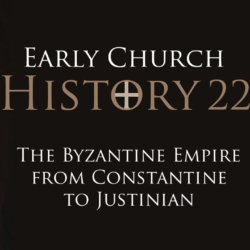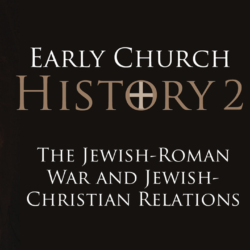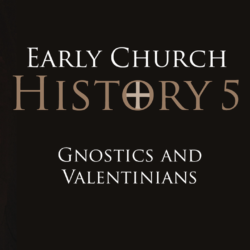This is part 21 of the Early Church History class.
In the fifth century Christians waged a theological civil war that ended in a massive church split. The issue was over the dual natures of Christ. How was he both divine and human? Did he have a human soul and a divine soul? Did his two natures fuse into one new nature? Although such abstruse distinctions would hardly get anyone’s blood boiling today, these doctrinal distinctives resulted in a zero sum war for supremacy involving not only theological argumentation, but also political conniving and outright gangster tactics in the battles that led to the famous Council of Chalcedon in 451. Though church history textbooks often whitewash this period of theological creativity, this episode will give you a brief but unapologetic overview of the major players and their deeds in the dual natures controversy.
Listen to this episode on Spotify or Apple Podcasts
—— Links ——
- More Restitutio resources on Christian history
- See other classes here
- Support Restitutio by donating here
- Join our Restitutio Facebook Group and follow Sean Finnegan on Twitter @RestitutioSF
- Leave a voice message via SpeakPipe with questions or comments and we may play them out on the air
- Intro music: Good Vibes by MBB Attribution-ShareAlike 3.0 Unported (CC BY-SA 3.0) Free Download / Stream: Music promoted by Audio Library.
- Who is Sean Finnegan? Read his bio here
—— Notes ——
Options for Two Natures
- Athanasius (c. 357) affirmed Jesus as God and man but did not explain how the natures united. He called Mary Theotokos (God-bearer).
- Apollinarius of Laodicea (d. 382) said the Word became flesh without assuming a human mind (Apollinarianism).
- Gregory of Nazianzus (d. 390) condemned Apollinarius and said that what God has not assumed, he has not healed.
- Eutyches of Constantinople (380-456) said the divine and human natures combined to form one new nature (Eutychianism/Monophysitism)
- Nestorius (c. 429) denied Mary as Theotokos, calling her instead Christotokos, and allegedly taught that Christ had two distinct natures in two persons (Nestorianism/dyophysitism).
- Leo I said Christ had two natures united in person, though the two natures remained distinct (Chalcedonian dyophysitism).
Condemning John Chrysostom
- John Chrysostom represented the Antiochene school of thought (as opposed to the Alexandrian).
- 397 Chrysostom became bishop of Constantinople.
- Eudoxia, wife of the emperor Arcadius, worked with Theophilus of Alexandria to depose Chrysostom.
- 403 Synod of the Oak deposed Chrysostom.
- 404 Chrysostom exiled.
- 407 Chrysostom marched to death
Condemning Nestorius
- 428 Nestorius became bishop of Constantinople.
- He immediately began persecuting “heretics” as a defender of orthodoxy.
- 429 Anastasius of Antioch preached in Constantinople that no one should call Mary
- Pulcheria, sister of emperor Theodosius II, worked with Cyril of Alexandria to depose Nestorius.
- 431 1st Council of Ephesus deposed Nestorius.
Condemning Flavian
- 446 Flavian became bishop of Constantinople.
- 448 Held a synod that interrogated and condemned Eutyches
- 449 2nd Council of Ephesus reinstated Eutyches and condemned Flavian.
- Dioscorus of Alexandria instigated violence against Flavian that resulted in his death.
- Known to history as the “Robber Synod”
Chalcedon
- 450 Theodosius II fell from his horse and died, leaving Pulcheria, his sister the nun, to marry Marcian, the new emperor.
- 451 Marcian and Pulcheria called the council at Chalcedon to reverse the 2nd Council of Ephesus and depose Dioscorus.
- Pope Leo’s tome was read and accepted.
- After much debate, they codified the definition of Chalcedon, declaring Mary as Theotokos and Christ as having two natures in one person.
- When Nestorius read Leo’s tome, he agreed with him and called it orthodox.
- Several important groups of churches, both Nestorian and Monophysite, rejected Chalcedon, including Egypt, Ethiopia, Armenia, Syria, and Persia.
Review
- Deciding how the divine and human natures worked in Christ became the chief focus for many Christians in the fifth century.
- Apollinarius of Laodice proposed that the logos (Word) replaced the human mind, the rational part of the soul, in Christ (Apollinarianism).
- Eutyches proposed that Christ was one nature after the union of the divine and human (monophysitism).
- Pope Leo I said the two natures retained their distinctive characters in the one person of Christ (dyophysitism).
- Nestorius allegedly taught that the two natures in Christ were not united in one person (Nestorianism), though this was probably a misrepresentation of Cyril of Alexandria.
- Powerful Alexandrian bishops worked with powerful empresses to outmaneuver and depose Constantinopolitan bishops John Chrysostom in 404 and Nestorius in 431.
- Nestorius tried to steer people away from calling Mary Theotokos (God-bearer) by calling her Christotokos (Christ-bearer), but this offended many.
- Alexandrian bishops from Theophilus to Cyril to Dioscorus increasingly used gangster tactics to intimidate, coerce, beat, and even kill their theological-political opponents.
- The Chalcedonian definition of 451 condemned Nestorius and Eutyches while endorsing Cyril and Leo, promoting a diophysite statement of two natures in one person, united but not confused.
- Though trumpeted as “orthodox”, Chalcedon alienated a huge portion of Christianity, including the Coptic Church, Ethiopian Church, Syrian Church, Armenian Church, and Assyrian Church.







I’ve loved this class. I started because i wanted to understand the history of the apostles creed. Do you have any other podcasts on this topic?